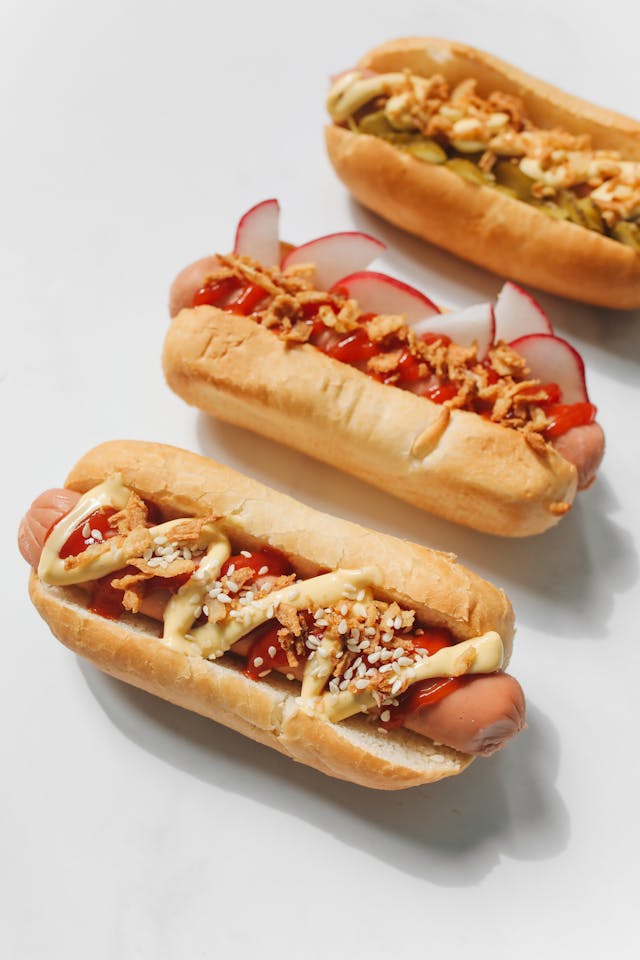While America may claim the hotdog as its iconic street food, Europe has elevated this humble sausage-in-a-bun to remarkable culinary heights. Across the continent, each country offers its own distinctive take on this beloved street food, transforming basic ingredients into regional masterpieces. For food enthusiasts looking to embark on a unique European culinary trail, hotdogs offer a delicious window into local food cultures.
Traveling between these destinations has never been easier, with companies like https://bcs-bus.com/ offering specialized culinary tours that allow you to sample the continent’s best hotdogs while enjoying comfortable transportation between cities. This combination of convenient travel and culinary exploration makes a European hotdog tour an appealing option for food-loving travelers.
Denmark: The Sophisticated Pølse
The Danish hotdog, or “rød pølse,” stands as perhaps Europe’s most renowned version. Traditionally, a bright red sausage is served on a warm, fresh bun and topped with both raw and fried onions, thinly sliced pickles, and a rainbow of condiments including ketchup, mustard, and remoulade (a Danish sauce with mayonnaise, herbs, and capers).
For the quintessential experience, visit Copenhagen’s DØP stands, which have revolutionized the Danish hotdog scene by using organic meat and artisanal breads. The “Klassisk Hotdog” remains their bestseller, but more adventurous eaters should try their seasonal specials featuring local ingredients.
Sweden: The Tunnbrödsrulle Challenge
Sweden’s unique contribution to hotdog culture is the massive “tunnbrödsrulle.” This creation wraps a hotdog (or often two) in soft flatbread rather than a traditional bun. The standard version comes loaded with mashed potatoes, shrimp salad, crispy fried onions, and a variety of sauces.
In Stockholm, Günters on Karlbergsvägen has been perfecting this dish since 1981. Their “Special” version adds fresh lettuce and cucumber to create a refreshing contrast to the rich sausage and potato base. Be warned: finishing an entire tunnbrödsrulle in one sitting qualifies as a noteworthy achievement.
Germany: Regional Wursts With History
Germany boasts perhaps the greatest variety of sausages in Europe, with regional specialties that reflect centuries of butchery tradition. In Berlin, the currywurst reigns supreme—sliced pork sausage topped with curry-spiced ketchup and served with a fresh bread roll.
Konnopke’s Imbiss, operating beneath the elevated train tracks in Berlin’s Prenzlauer Berg since 1930, serves what many consider the definitive version. For a different German take, try the long, thin Nürnberger sausages served six at a time on a heart-shaped tin in Nuremberg’s old town.
Iceland: The Pylsur Phenomenon
Iceland’s national fast food, the “pylsur,” has developed a cult following among travelers. The standard Icelandic hotdog combines pork, beef, and lamb sausage in a natural casing, creating a distinctive snap when bitten.
The iconic Bæjarins Beztu Pylsur stand in Reykjavik—where even Bill Clinton has dined—serves their hotdogs “ein með öllu” (with everything): ketchup, sweet brown mustard, remoulade, crispy fried onions, and raw onions. The combination of sweet, savory, and crunchy makes this humble hotdog unexpectedly complex.
France: The Sophisticated Street Dog
While not traditionally known for hotdogs, France has recently embraced gourmet versions that incorporate French culinary techniques. In Paris, Le Voltigeur serves hotdogs featuring artisanal sausages on freshly baked baguettes with toppings like caramelized onions, truffle mayonnaise, and Comté cheese.
For something truly unique, try the “Hotdog Français” at Frenchie To Go, where chef Gregory Marchand creates seasonal variations featuring ingredients like duck confit sausage and homemade sauerkraut.
Norway: The Distinctive Pølse
Norwegian hotdogs, like their Scandinavian neighbors, hold a special place in the country’s food culture. What makes the Norwegian version unique is the option to have your sausage wrapped in potato lefse (a soft flatbread) rather than a traditional bun.
In Oslo, visit Syverkiosken, a kiosk operating since 1979, for their reindeer sausage with lingonberry sauce—a truly Nordic culinary experience that combines wild game flavors with sweet-tart berries.
Czech Republic: The Hearty Párek v Rohlíku
In Prague, the “párek v rohlíku” (sausage in a roll) offers a unique approach to the hotdog. Rather than placing the sausage in a sliced bun, vendors hollow out a Czech roll and insert the sausage into this bread sleeve, then add condiments.
The result is portable and less messy than traditional hotdogs. Try this local specialty at Bufet Bufet in Prague’s Karlín district, where they’ve elevated the simple street food with homemade sauces and premium meat.
Italy: The Unexpected Contender
Italy might be famous for pasta and pizza, but in the northern city of Turin, the “hot dog di Portici” has become a beloved street food. This Italian interpretation features a grilled sausage made with local Piedmontese beef, served on a crusty roll with roasted peppers, local cheese, and olive tapenade.
For an authentic experience, visit Gazebo di Valentino near the city’s famous arcade, where the blend of Italian ingredients with the familiar hotdog format creates something entirely new.
Planning Your European Hotdog Tour
With such diversity across relatively short distances, a European hotdog tour makes for an enjoyable culinary adventure. Travelers can easily connect these hotdog destinations via BCS-Bus, whose European culinary routes offer comfortable transportation between major cities with stops at renowned food spots along the way.
Their specialized “European Street Food Explorer” package even includes guided tastings at selected stands, with local food experts sharing the history and cultural significance of each region’s unique hotdog tradition.
Whether you’re a dedicated food tourist or simply looking for an accessible way to experience authentic local cuisine, Europe’s hotdog scene offers flavors to satisfy every palate. From Copenhagen’s gourmet pølse to Berlin’s curry-dusted wurst, these handheld delights tell delicious stories about their home countries—no fine dining reservation required.
